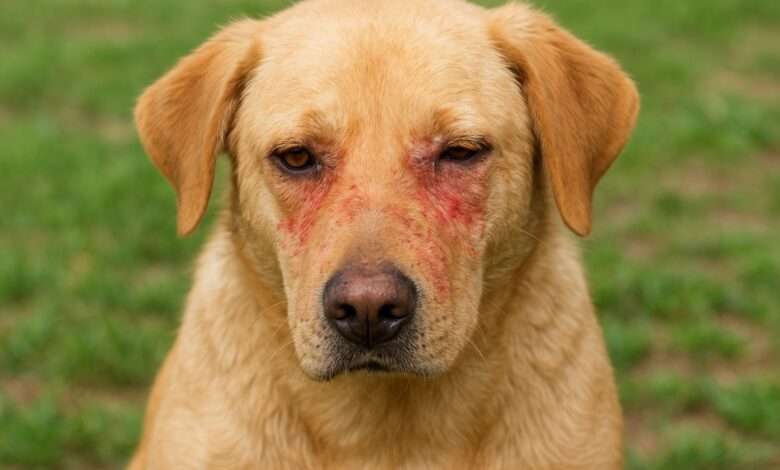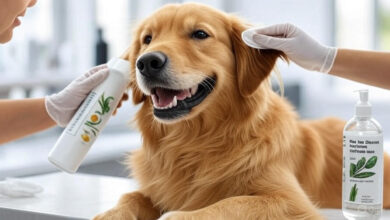Best Food for Dogs with Allergies and Yeast Infections (Complete Vet Guide 2025)
Allergies and Yeast Infections

If your dog constantly scratches, licks its paws, or has red, smelly ears, it might be suffering from yeast infections or food allergies. Many pet parents struggle to find the best dog food for yeast infections that truly helps their pets heal.
In this guide, we’ll discuss the best and worst foods for dogs with yeast problems, expert vet recommendations, and how to choose yeast-free nutrition that supports your dog’s long-term health.
🩺 Understanding Yeast Infections in Dogs
A yeast infection in dogs happens when there’s an overgrowth of Malassezia pachydermatis, a natural fungus that lives on the skin and ears. Normally harmless, it becomes a problem when your dog’s immune system is weakened or when their diet triggers inflammation.
Common Signs of Yeast Infections:
-
Persistent scratching or licking (especially paws and ears)
-
Red or brown discoloration on paws
-
Musty or “corn chip” smell
-
Hair loss around infected areas
-
Frequent ear shaking and wax buildup
👉 If you notice these symptoms, your first step should be a vet visit to confirm a yeast infection. Once confirmed, adjusting your dog’s diet plays a major role in recovery.
🍗 How Food Affects Yeast Infections in Dogs
Diet is one of the most powerful tools to control yeast. Yeast feeds on sugar and carbohydrates, so a high-carb or poor-quality food worsens the condition.
Ingredients That Trigger Yeast Overgrowth:
-
Corn, wheat, and soy
-
Starchy vegetables (like potatoes and peas in excess)
-
Artificial colors, flavors, and preservatives
-
Sugary treats or table scraps
To fight yeast, focus on a low-carbohydrate, grain-free, and high-protein diet made from natural ingredients.
🦴 Best Food for Dogs with Allergies and Yeast Infections
Let’s explore the vet-approved best dog food options that help manage both yeast infections and allergies naturally.
1. Best Dry Dog Food for Yeast Infections
🐶 Brand Example: Hill’s Science Diet Sensitive Skin & Stomach Grain-Free
This formula supports dogs with sensitive digestion and skin allergies.
Why it’s great:
-
Made with salmon and potato — gentle on the stomach
-
Contains prebiotic fiber for healthy gut bacteria
-
No wheat, soy, or corn
Tip: Always ensure the dry food is grain-free and uses limited ingredients to prevent allergen triggers.
2. Best Wet Dog Food for Yeast Infections
🐾 Brand Example: Blue Buffalo Basics Skin & Stomach Care (Wet)
Wet food helps hydrate dogs and supports digestion.
Why it’s recommended:
-
Uses single animal protein (turkey or lamb)
-
Grain-free and no artificial additives
-
Gentle for dogs with chronic yeast issues
Pro Tip: Rotate between dry and wet yeast-free food to improve nutrition balance and taste variety.
3. Best Dog Food for Yeast Infections in Ears
🐕 Brand Example: Zig nature Kangaroo Formula
Dogs with ear yeast infections benefit from novel protein sources (meat they haven’t eaten before).
Why it helps:
-
Kangaroo is hypoallergenic and anti-inflammatory
-
No potatoes, grains, or soy
-
Rich in omega-3 for ear and skin healing
Note: Omega-3 fatty acids reduce ear inflammation and prevent yeast buildup naturally.
4. Best Food for Dogs with Allergies and Yeast Infections (Natural Options)
🌿 Example: The Honest Kitchen Dehydrated Whole Food (Turkey Recipe)
This human-grade, natural formula contains no fillers or preservatives.
Benefits:
-
100% natural ingredients
-
High in protein and low in carbs
-
Easy to digest and gut-friendly
Natural Add-ons for Yeast Control:
-
Coconut oil (antifungal properties)
-
Plain Greek yogurt (probiotic support)
-
Apple cider vinegar (balances skin pH when diluted for topical use)
Always consult your vet before adding supplements or natural remedies.
5. Best Dry Dog Food for Skin Allergies and Yeast
🐕🦺 Example: Purina Pro Plan Sensitive Skin & Stomach (Salmon & Rice)
Perfect for dogs with both skin allergies and yeast infections.
Key benefits:
-
Omega-6 and zinc for healthy skin
-
No artificial preservatives
-
High protein from real salmon
6. Yeast-Free Dog Food Recommendations
If you’re searching for yeast-free dog food, here are top ingredients to look for:
-
Animal-based protein (chicken, fish, turkey, or lamb)
-
Vegetables like spinach, carrots, and broccoli
-
Healthy fats: salmon oil, coconut oil, flaxseed
-
No added sugar or simple starch
Recommended Yeast-Free Brands:
-
Canidae PURE Limited Ingredient
-
Wellness Core Grain-Free
-
Merrick Limited Ingredient Diet
🚫 Worst Dog Food for Yeast Infection (Avoid These!)
Not all dog foods are healthy—even some marketed as “premium” can worsen yeast problems.
Below are ingredients and brands to avoid.
1. High-Carb or Sugary Foods
-
Foods containing corn, soy, or wheat
-
Sweet potatoes in high amounts
-
Dog biscuits and treats with sugar
2. Artificial Preservatives and Flavors
-
BHA, BHT, Ethoxyquin
-
Artificial color dyes
3. “Worst Homemade Dog Food” for Yeast Infection
Homemade diets are not always safe unless balanced by a vet.
Avoid:
-
Rice or white flour as base
-
Cooked starch vegetables (potatoes, peas, or corn)
-
Human leftovers and dairy-rich recipes
👉 Safe Homemade Alternative:
Cooked turkey or fish + green beans + small portion of pumpkin puree.
🍲 Homemade Dog Food for Allergies and Yeast Infections (Vet-Approved Recipe)
Here’s a simple and natural yeast-control recipe you can prepare at home:
Ingredients:
-
1 cup ground turkey or lean chicken
-
½ cup chopped spinach
-
¼ cup pumpkin puree (fiber for gut)
-
1 teaspoon coconut oil
-
½ cup water
Instructions:
-
Cook the meat in a nonstick pan until brown.
-
Add vegetables and simmer for 10 minutes.
-
Stir in coconut oil.
-
Cool before serving.
Serve in small portions and refrigerate leftovers for up to 3 days.
Always consult your vet before switching to homemade diets.
❓ Frequently Asked Questions (FAQs)
1. What food kills yeast in dogs?
Foods high in protein and low in carbs, like salmon, turkey, and leafy greens, help kill yeast. Avoid sugar, wheat, and corn.
2. What is the best natural food for dogs with yeast infections?
Human-grade natural food such as The Honest Kitchen Dehydrated Whole Food (Turkey Recipe) is great. Add coconut oil and probiotics for extra support.
3. Can yeast infection come from dog food?
Yes, high-carb or grain-heavy food promotes yeast overgrowth and worsens infections, especially in the ears and paws.
4. How long does it take for yeast infection to improve with diet?
It usually takes 4 to 6 weeks of consistent feeding with yeast-free food to see visible improvement.
5. Is homemade food good for yeast infections?
Yes, but it should be vet-approved and balanced. Homemade meals with lean meat, vegetables, and healthy oils work well.
6. Should I avoid grains for dogs with yeast infections?
Absolutely. Grains are high in carbs, which feed yeast and worsen infections. Choose grain-free, low-carb diets.
🐾 Final Thoughts
Feeding the best food for dogs with allergies and yeast infections can completely change your pet’s health. Choose low-carb, grain-free, and natural dog food that strengthens your dog’s immune system, improves skin health, and prevents recurring yeast problems.
Always consult your veterinarian before changing your dog’s diet, and remember — good nutrition is the foundation of long-lasting wellness for your furry friend.





